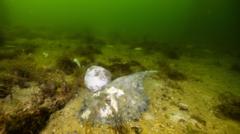The toxic algal bloom devastating South Australia has triggered severe environmental and economic repercussions, leading the state premier, Peter Malinauskas, to label the situation a "natural disaster." This extraordinary proliferation of algae, set off by climate change factors like ocean warming and marine heatwaves, has engulfed local waters in a toxic green hue and resulted in the deaths of over 400 marine species.
Since its emergence in March, the bloom has expanded significantly, now covering an area twice the size of the Australian Capital Territory. While the federal government has introduced a A$14 million ($9 million) assistance package for affected regions, it refuses to classify the incident as a natural disaster—traditionally associated with events like cyclones or bushfires that would warrant a more substantial governmental response.
In response to the environmental and economic collapse, Premier Malinauskas announced that his government would match the federal assistance, directing funds towards research, cleanup activities, and support for impacted industries. Criticism of the federal government is rising, with South Australian Greens Senator Sarah Hanson-Young accusing them of downplaying the crisis.
"Had this issue occurred at popular beaches in Sydney, the Prime Minister would have taken immediate action," she stated, reflecting the frustration felt among affected communities.
Federal Environment Minister Murray Watt has acknowledged the distressing nature of the bloom but maintains that it does not meet the criteria for a natural disaster under national laws. Experts describe the situation as particularly alarming, indicating that the bloom stretches from Coorong to the Yorke Peninsula, a region now lined with dead wildlife and suffering a profound ecological impact.
Local fishermen have reported devastating income losses, with anecdotal evidence of fishermen in tears due to prolonged financial distress. The crisis paints a grim picture for both the local marine ecosystem and the livelihoods of those who depend on fishing, as they grapple with the aftermath of this widespread algae outbreak.
Since its emergence in March, the bloom has expanded significantly, now covering an area twice the size of the Australian Capital Territory. While the federal government has introduced a A$14 million ($9 million) assistance package for affected regions, it refuses to classify the incident as a natural disaster—traditionally associated with events like cyclones or bushfires that would warrant a more substantial governmental response.
In response to the environmental and economic collapse, Premier Malinauskas announced that his government would match the federal assistance, directing funds towards research, cleanup activities, and support for impacted industries. Criticism of the federal government is rising, with South Australian Greens Senator Sarah Hanson-Young accusing them of downplaying the crisis.
"Had this issue occurred at popular beaches in Sydney, the Prime Minister would have taken immediate action," she stated, reflecting the frustration felt among affected communities.
Federal Environment Minister Murray Watt has acknowledged the distressing nature of the bloom but maintains that it does not meet the criteria for a natural disaster under national laws. Experts describe the situation as particularly alarming, indicating that the bloom stretches from Coorong to the Yorke Peninsula, a region now lined with dead wildlife and suffering a profound ecological impact.
Local fishermen have reported devastating income losses, with anecdotal evidence of fishermen in tears due to prolonged financial distress. The crisis paints a grim picture for both the local marine ecosystem and the livelihoods of those who depend on fishing, as they grapple with the aftermath of this widespread algae outbreak.






















